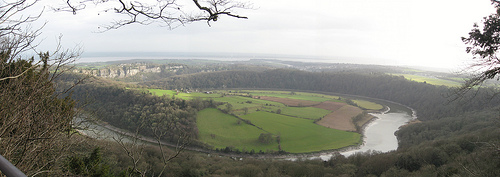Earlier this year I wrote about the use of the phrase 13 shire view. I connected an early 17th century poem in which it was mentioned, with late 18th century descriptions of the view from the column at Hawkstone Park -as ’13 county view’. And asked (myself, as it turned out) whether that 13 shire (or 13 county) view could be a regular theme in English landscape descriptions, or whether this short line from the 1611 poem by Aemelia Lawnyer still resonated almost two centuries later.
Eagles Nest, view over the river Wye and the Severn. Photo: Peter Turvey (click to see the original on flickr).
Today I found the phrase again, also used in the late 18th century. It is mentioned in the description of a view 2 miles north of Chepstow, Monmouthshire, Wales. 1Corita Myerscough [ed.], ‘Amelia Clark’s Journal of the Tour made in the year 1796’, in Uncle John Carr. The Diaries of his Great-nieces, Harriet and Amelia Clark (York Georgian Society, 2000), p48. The author is Amelia Clark, great-niece of celebrated Yorkshire architect John Carr, who accompanied her on a tour through the country in 1796. 2During this trip, he visited many locations he had already seen the year before with her elder sister. As their stories are often the same, it is clear he was showing the young girls around. They were often visiting places where he himself had worked, so he obviously knew most of the places already. Coming from Gloucester they crossed the Severn on a September morning and travelled into Wales to the town of Monmouth to have breakfast. Afterwards they traveled south along the banks of the winding river Wye to Chepstow, a known ‘beautiful & picturesque’ route at the time. Although Amelia liked the landscape around Lake ‘Windermeer’ better in those respects, she singled out one view:
The road from Monmouth to Chepstow is very mountainous with many noble views; particularly at two miles distance from Chepstow there is the most extensive and animated view in the Kingdom. You see distinctly into thirteen counties, through the Center of which the sublime Severn Rolls with Majestic grandeur.
The setting she describes is comparable to the one in the photo above: the view from Eagles Nest just east of St. Arvans. The view from the road (which lies lower than Eagles Nest) is now blocked by trees, I assume this was not the case when she travelled there.
So, apart from showing that she knows how to use all the fashionable words to describe landscapes -beautiful, picturesque, noble, sublime (even the unusual majestic), she also refers to that phrase ’13 county view’.
I am still wondering how common this phrase was at the time. Especially after finding a (recent?) use of it in relation to the Hill of Tara, in Ireland. Is it just a common expression that I -as a foreigner- think is special?
Footnotes
| ↑1 | Corita Myerscough [ed.], ‘Amelia Clark’s Journal of the Tour made in the year 1796’, in Uncle John Carr. The Diaries of his Great-nieces, Harriet and Amelia Clark (York Georgian Society, 2000), p48. |
|---|---|
| ↑2 | During this trip, he visited many locations he had already seen the year before with her elder sister. As their stories are often the same, it is clear he was showing the young girls around. They were often visiting places where he himself had worked, so he obviously knew most of the places already. |



